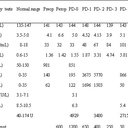Perioperative anesthetic and surgical complications of the Nuss procedure.
Cuvinte cheie
Abstract
OBJECTIVE
The Nuss procedure is a chest wall remodeling surgery performed in patients with pectus excavatum. This study was performed to analyze perioperative surgical and anesthetic complications with the Nuss procedures.
METHODS
A retrospective analysis.
METHODS
An academic hospital.
METHODS
Two hundred fourteen patients (children, adolescents, and adults) undergoing the Nuss procedure over 6 years.
METHODS
Patient age and sex, premorbid diseases, indications for surgery, patient position during the procedure, the length of surgery, time to hospital discharge, postoperative analgesia method, and the presence of perioperative complications were recorded.
METHODS
No mortality was observed. The overall complication rate was 18.7%, but the overall event rate was 42.6% (91 events in 40 patients). Intraoperative hypotension, tachycardia, and hypercapnia were the most common complications (4.7%), followed by postoperative ileus (3.2%), pneumothorax (right, left, or bilateral; 4.2%), lung parenchymal laceration (2.3%), and postoperative nausea and vomiting (2.3%). Two patients had an ulnar nerve palsy and 1 patient had a brachial nerve palsy as a result of surgical position.
CONCLUSIONS
Although the Nuss procedure is reported to be minimally invasive, some serious complications concerning both surgery and anesthesia should not be overlooked.



